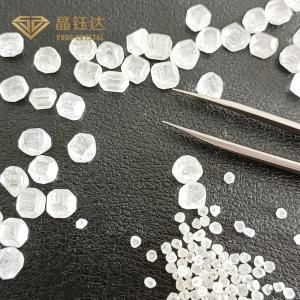
Add to Cart
1Ct 2Ct VVS VS Clarity DEF Colour HPHT Lab Grown Diamonds For Ring
Lab Created Diamonds Description
Cultured diamond is laboratory synthetic "real" diamond: lab creared diamond is through modern technology in the laboratory to simulate the growth environment of natural diamond to grow out of the diamond, and natural diamond attributes, are real diamond. The birth of lab created diamond can be traced back to the 1950s. There are two main methods to produce and lab created diamonds: high temperature and high pressure method (HPHT) and chemical meteorological deposition (CVD). Compared with natural diamond, lab created diamond has obvious advantages in quality (providing bigger and more beautiful diamond), cost (the price is only one third of natural diamond), environmental protection (lab created diamond saves water resources, reduces land loss, carbon emissions) and other aspects. Now lab grown diamond has obtained IGI, GIA and NGTC national inspection certificates.
The so-called "lab created diamond", known as laboratory cultivation diamond, also known as growth diamond, known as synthetic diamond in the national standard. Lab grown diamond products are comparable to natural diamond in crystal structure integrity, transparency, refractive index, dispersion and other aspects. As an emerging choice in diamond consumption field, lab grown diamond products can be used to make diamond rings, necklaces, earrings and other diamond accessories and other fashion consumer goods.
Parameters Of Lab Created Diamonds
| Product Name | Synthetic (Lab created) diamond |
| Material | Lab-grown |
| Color | D-H |
| Size | 35PCS/CT-5CTS/PC |
| Grade | VVS VS SI |
| Used | Jewelry (necklace,ring) |
| Application | For Cutting Lab Grown Loose Diamonds |
| Place Of Origin | Zhengzhou, China |
Characteristics Of Lab Created Diamonds
Lab-grown diamonds are chemically, optically and structurally identical to mined diamonds. What does that mean?
| The Difference Between Lab Diamond And Natural Diamond | |||
| Attribute | Lab Created Diamonds | Natural diamond | Distinction |
| Chemical composition | C(carbon) | C(carbon) | No |
| Refractive index | 2.42 | 2.42 | No |
| Relative density | 3.52 | 3.52 | No |
| Dispersion | 0.044 | 0.044 | No |
| Hardness value | 90 GPA | 90 GPA | No |
| Thermal conductivity | 2*103 W/M/K | 2*103 W/M/K | No |
| Thermal property | 0.8*10-6 K | 0.8*10-6 K | No |
| Light transmittance | DEEP UV TO FAR TR | DEEP UV TO FAR TR | No |
| Resistivity | 1016 OHM-CM | 1016 OHM-CM | No |
| Compressibility | 8.3*10-13 M2/N | 8.3*10-13 M2/N | No |
From a scientific point of view, cultivated diamonds are exactly the same as natural diamonds, the only difference being where they are formed.
Lab-grown diamonds have exactly the same physical, chemical and optical properties as natural diamonds, and have a hardness of 10.
Lab Created Diamonds Details
